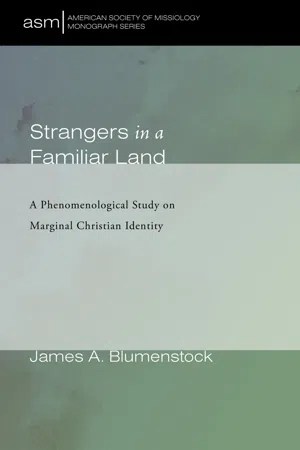
Strangers in a Familiar Land
A Phenomenological Study on Marginal Christian Identity
- 276 pages
- English
- ePUB (mobile friendly)
- Available on iOS & Android
Strangers in a Familiar Land
A Phenomenological Study on Marginal Christian Identity
About this book
Throughout history, many Christians have existed on the margins of society; deviants and strangers in lands they call home. To survive, they have had to construct alternate identities that not only make sense of their religious experiences and beliefs but also equip them to successfully negotiate their social worlds. In Thailand, a nation where social identities are thoroughly intertwined with Buddhist religious adherence, Christians must come to terms with such a marginalized existence. By leaving Buddhism and adopting what is considered a foreign faith, Christian converts become deviants to "normal" Thai identity and belonging. In response, they have discovered creative solutions for traversing this complex terrain of marginalization.This book presents a deep exploration of the phenomenon of marginalization as experienced by Thai Christian converts. In it, readers will follow participants through the heights of transformative religious experience, the lows of severe social displacement, the tensions of managing two disparate lifeworlds and two conflicting selves, and the comfort and joy of finding a new place to call home. In the end, the reader will gain deep insight into what it is like to successfully navigate a minority religious identity on the margins of society.
Frequently asked questions
- Essential is ideal for learners and professionals who enjoy exploring a wide range of subjects. Access the Essential Library with 800,000+ trusted titles and best-sellers across business, personal growth, and the humanities. Includes unlimited reading time and Standard Read Aloud voice.
- Complete: Perfect for advanced learners and researchers needing full, unrestricted access. Unlock 1.4M+ books across hundreds of subjects, including academic and specialized titles. The Complete Plan also includes advanced features like Premium Read Aloud and Research Assistant.
Please note we cannot support devices running on iOS 13 and Android 7 or earlier. Learn more about using the app.
Information
Identity Formation in Sociocultural Perspective
Table of contents
- Title Page
- Acknowledgements
- Introduction
- Chapter 1: Identity Formation in Sociocultural Perspective
- Chapter 2: Phenomenology of the Sacred Homeworld
- Chapter 3: Negotiating Christian Identity
- Chapter 4: Phenomenology as Method and Methodology
- Chapter 5: Thai Buddhist Homeworld
- Chapter 6: Verticality
- Chapter 7: Emplacement
- Chapter 8: Displacement
- Chapter 9: Negotiation
- Conclusion: Retrospect and Prospect
- Appendix on Interview Questions
- Bibliography